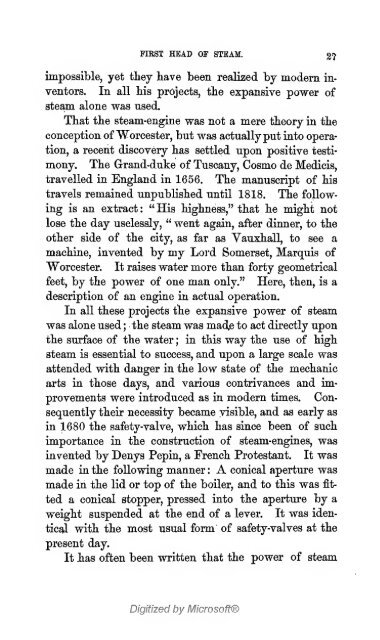The history of the first locomotives in America. From original ...
The history of the first locomotives in America. From original ...
The history of the first locomotives in America. From original ...
You also want an ePaper? Increase the reach of your titles
YUMPU automatically turns print PDFs into web optimized ePapers that Google loves.
FIEST HEAD OF STEAM. 31^<br />
impossible, yet <strong>the</strong>y have been realized by modem <strong>in</strong>-<br />
ventors. In all his projects, <strong>the</strong> expansive power <strong>of</strong><br />
steam alone was used.<br />
That <strong>the</strong> steam-eng<strong>in</strong>e was not a mere <strong>the</strong>ory <strong>in</strong> <strong>the</strong><br />
conception <strong>of</strong> Worcester, but was actually put <strong>in</strong>to opera-<br />
tion, a recent discovery has settled upon positive testimony.<br />
<strong>The</strong> Grrand-duke <strong>of</strong> Tuscany, Cosmo de Medicis,<br />
travelled <strong>in</strong> England <strong>in</strong> 1656. <strong>The</strong> manuscript <strong>of</strong> his<br />
travels rema<strong>in</strong>ed unpublished until 1818. <strong>The</strong> follow-<br />
<strong>in</strong>g is an extract : " His highness," that he might not<br />
lose <strong>the</strong> day uselessly, " went aga<strong>in</strong>, after d<strong>in</strong>ner, to <strong>the</strong><br />
o<strong>the</strong>r side <strong>of</strong> <strong>the</strong> city, as far as Vauxhall, to see a<br />
mach<strong>in</strong>e, <strong>in</strong>vented by my Lord Somerset, Marquis <strong>of</strong><br />
"Worcester. It raises water more than forty geometrical<br />
feet, by <strong>the</strong> power <strong>of</strong> one man only." Here, <strong>the</strong>n, is a<br />
description <strong>of</strong> an eng<strong>in</strong>e <strong>in</strong> actual operation.<br />
In all <strong>the</strong>se projects <strong>the</strong> expansive power <strong>of</strong> steam<br />
was alone used ; <strong>the</strong> steam was made to act directly upon<br />
<strong>the</strong> surface <strong>of</strong> <strong>the</strong> water ; <strong>in</strong> this way <strong>the</strong> use <strong>of</strong> high<br />
steam is essential to success, and upon a large scale was<br />
attended with danger <strong>in</strong> <strong>the</strong> low state <strong>of</strong> <strong>the</strong> mechanic<br />
arts <strong>in</strong> those days, and various contrivances and im-<br />
provements were <strong>in</strong>troduced as <strong>in</strong> modern times. Con-<br />
sequently <strong>the</strong>ir necessity became visible, and as early as<br />
<strong>in</strong> 1680 <strong>the</strong> safety-valve, which has s<strong>in</strong>ce been <strong>of</strong> such<br />
importance <strong>in</strong> <strong>the</strong> construction <strong>of</strong> steam-eng<strong>in</strong>es, was<br />
<strong>in</strong>vented by Denys Pep<strong>in</strong>, a French Protestant. It was<br />
made <strong>in</strong> <strong>the</strong> follow<strong>in</strong>g manner : A conical aperture was<br />
made <strong>in</strong> <strong>the</strong> lid or top <strong>of</strong> <strong>the</strong> boiler, and to this was fit-<br />
ted a conical stopper, pressed <strong>in</strong>to <strong>the</strong> aperture by a<br />
weight suspended at <strong>the</strong> end <strong>of</strong> a lever. It was iden-<br />
ticg,l with <strong>the</strong> most usual form <strong>of</strong> safety-valves at <strong>the</strong><br />
present day.<br />
It has <strong>of</strong>ten been written that <strong>the</strong> power <strong>of</strong> steam<br />
Digitized by Micros<strong>of</strong>t®
















